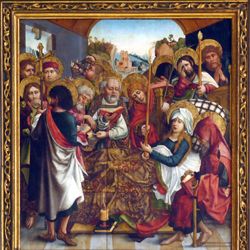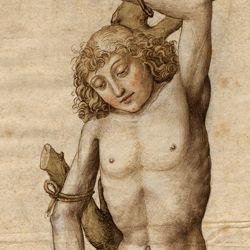Hans d. Ä.
Traut (Drack, Hans von Speyer, Spira)
painter, draftsman, stained glass designer
born Speyer
buried Nürnberg, 15. May 1516
* probably Speyer – founded May 15, 1516 Nuremberg.
Father or uncle of Wolf Traut. ∞ Katharina, two daughters proven. In 1477 “Hanns Trautt Maler” acquired the Nuremberg citizenship for 2 fl. From 1488 to 1504 he received payments from the abbots of the Cistercian monastery in Heilsbronn, including for stained glass with a Mother of God and a Heilsbronn coat of arms for the chapter house.
In 1491/93 he was paid for work by Elector Frederick the Wise of Saxony.
In 1494 Traut was involved in a legal dispute with Rupprecht Kolberger over a board or panel. In 1496 the Nuremberg council paid him 10 shillings for repairing coats of arms. In 1499 Traut had a dispute with the carpenter Hans Mullner and in the same year with Diepolt Zeller from Eichstätt over work he had undertaken under contract; the council issued him two letters of recommendation.
In 1502, Traut witnessed the conclusion of a marriage contract. Two years later, the council had the value of one of his shields estimated and communicated the result to Ernst von Vestenberg. Traut worked with Veit Stoss, to whom he owed money for carvings in 1505.
In 1510 and 1511 “Hans von Speyer” vouched for the carpenter Hans Baldauf. The well register created in 1479 shows that he lived at Spitalgasse 9 for rent with the sexton Katharina Pömler. In 1506 and
1508 he committed himself to paying 46 fl. and 3 Ort or 40 fl. rh. rent to Marquart Mendel. As a posthumous entry in the Libri Litterarum reveals,
Traut lived in Bindergasse, where Mendel owned the house at Bindergasse 7/Theresienstraße 16.
According to Neudörfer Traut went blind in old age.
The funeral chime books of St. Sebald and St. Lorenz record bells for the painter Hans von Speyer in 1516. Panzer recorded Traut's portrait.
Hans-Traut-Strasse in Nuremberg was named after him. According to the written sources, there are two works that are considered certain for Traut: the Marian retable (Katzwang, Marienkirche) is on the back of a predelle relief with the signature: “• 1498 • in die assu(mp)tio(nis) mar(iae) hans trawt by(n) speir painter”; The drawing of St. Sebastian (Erlangen, UB) was allegedly marked by Dürer with the note “dz hatt Hans trawt made normerchgk”. The watermark of the paper is proven in Nuremberg around 1480.
Johann Neudörfer states that Traut painted the now destroyed cloister of the Augustinian Church in Nuremberg. The inconsistent use of names, professional designations and designations of origin as well as the above-mentioned posthumous entry, which emphasizes that Traut was “commonly only called Hanns vonn Speier”, has led researchers to assume that there were two painters with the same name one after the other immigrated from Speyer to Nuremberg. According to Gümbel's assumption, the painter Hans Traut, who was recorded in the New Citizens' Book in 1477, died in 1487. The death knell of St. Lorenz records a death knell for a “Hanß von Speyer” this year. In the death knell book of St. Sebald, however, a “Hanns Drack von Speyer” is listed. Gümbel thought this was a prescription. According to Gümbel, a “Hans von Speyer” who immigrated in 1491 without an occupation was a younger relative of the older Hans Traut and died in 1516. Rauch rightly rejected the thesis of two painters because of the uncritical conclusion. Supported by other arguments, however, it has persisted until recently. The main argument is the incompatibility of the exquisite Sebastian drawing with the striking paintings in Katzwang. Strieder considered the drawing to be the work of the older painter, the paintings of the retable to be the work of the younger one. However, a relationship was seen between the drawing and the high-quality figure of Sebastian on the St. Vitus altar from the Augustinian monastery (Nuremberg, GNM), dated 1487, in the execution of which, following the theory of two painters, the older Traut is said to have been involved. Scholz also made a connection to a glass painting of St. Sebastian from the Tucher Chapel (today at Drehna Castle).
In fact, a second master named Hans Traut lived in Nuremberg. However, his profession was goldsmith. It cannot therefore be completely ruled out that the drawing represents the sight of a goldsmith's work. However, due to the relationship between the figure types of the Marian retable in Katzwang and St. Sebastian, it seems entirely plausible that both works come from the same painter's workshop. The “St. Sebastian” has greater authenticity in its capacity as a drawing than the reredos. The designation on the predella may only be understood as a workshop signature. Stylistic studies have shown that the reredos panels were painted by at least two painters.
The main painter of the Marian retable can be found in Langenzenn and Heilsbronn.
Whether he is Traut is an open question. Traut certainly headed a larger workshop. His collaborators cultivated a closely related style which, in comparison to the Wolgemut workshop, is more colourful and characterized by simply composed figures and scenes and an opaque application of paint. The participation of Wolf Traut in some of the works attributed to Traut cannot be verified. The revision of Hans Traut's oeuvre is a desideratum of research.
Works: Paintings: FRANKFURT/Main, Städel: Portrait of the Elector Frederick the Wise(?). HEILSBRONN, St. Mary and James: High altar retable and other altarpieces. KATZWANG, St. Mary's Church: Marienretabel, dat. LANGENZENN, Augustinerkirche: Altarpiece of the Descent from the Cross. NUREMBERG, St. Lawrence Church: Löffelholz epitaph, dat. 1504.
MuS: ERLANGEN, UB: St. Sebastian, drawing. NUREMBERG, GNM: St. Birgitta of Sweden; St. Vitus altar from the Augustinian church, dat. 1487(?).
References: Thieme-Becker; Murr, Journal, T. 15, p. 42; Murr, 1801; Neudörfer-Lochner, 1875, p. 136f.; Hampe, Rv. I, 682; Gümbel, 1906, p. 343f.; Chr. Rauch, Die Trauts, in: Studien zur deutschen Kunstgeschichte, Heft 79, 1907; Friedrich Lahusen: Der Hochaltar der ehemaligen Augustiner-Kirche St. Veit in Nürnberg, Diss. Freiburg i. Br. 1957; C. Jöckle, in: Mitteilungen des Historischen Vereins der Pfalz 88, 1990, pp. 69-87; Strieder, 1993; Löcher, 1997; Heilsbronn. A Cistercian monastery in Franconia. Edited by Paul Geißendörfer. Heilsbronn 2000;
Scholz, Glasmalerei 2002, pp. 66f., 563; German Paintings in the Städel
1300-1500, ed. by Bodo Brinkmann and Stephan Kemperdick (Kataloge der
Gemälde im Städelschen Kunstinstitut, Frankfurt/ Main, IV), Mainz 2002; Lata,
2005; Ausk. Karl Kohn.
Exhib.: 1971/3 no. 93; 1983/22; 2004/1, p. 61.
( quoted from the Nuremberg Artists' Dictionary, edited by Manfred H.Grieb. Sabine Lata)
Style: Late Gothic

